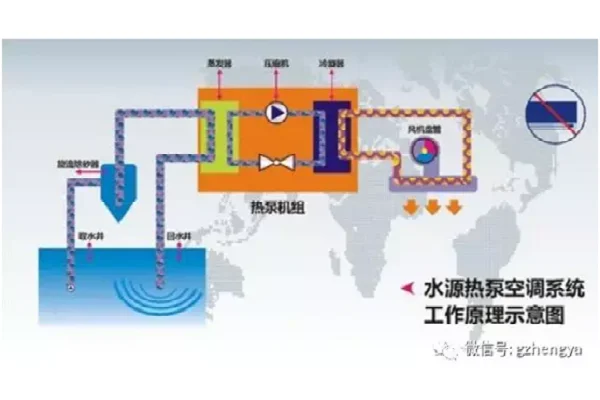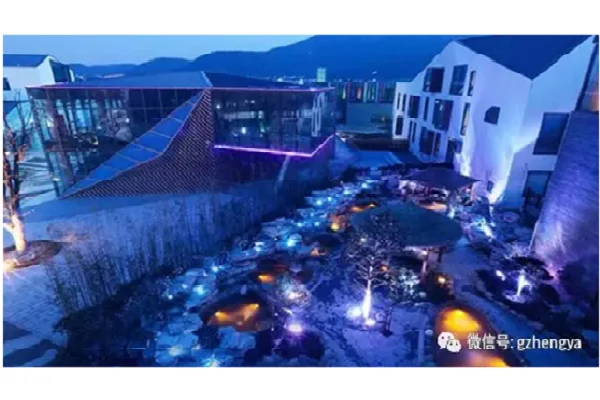Hot Spring Hotel Resort Center Water Source Heat Pump Solution
In view of the high residual heat of hot spring overflow, it is used as the water source for the low temperature side of the water source heat pump in winter. Compared with the conventional air conditioning scheme, the initial investment and operating costs will be reduced. At the same time, the calculation method of the overflow temperature of the bath center bath is proposed and discussed. Parameters and characteristics of the DC and hybrid water source approach.
Water source heat pump principle
The heat is transferred from high temperature to low temperature. The heat pump is a kind of heat lifting device that transfers heat from low temperature to high temperature. When it works, it consumes a small amount of electric energy, but extracts 4-7 times of heat energy from the environmental medium to raise the temperature. Utilization, this is also the reason for heat pump energy saving. The heat pump mainly consists of a compressor, an evaporator, a condenser, and an expansion throttle valve. The principle is as shown in the figure.

Compressor: It plays the role of compression and conveying circulating working medium from low temperature, low pressure to high temperature and high pressure. It is the heart of heat pump unit.
Evaporator: A device that outputs a cooling capacity. Its function is to evaporate the refrigerant liquid flowing in through the throttle valve to absorb the cooled heat for the purpose of cooling.
Condenser: A device that outputs heat. The heat absorbed from the evaporator, together with the heat converted by the compressor's work, is carried away by the cooling medium in the condenser to achieve the purpose of heating.
Expansion throttle valve: It reduces the throttling effect on the circulating working fluid and takes away the circulating working fluid flow into the evaporator.
When the heat pump heats up, the energy stored in the environmental medium is absorbed in the evaporator, and the heat is discharged from the condenser through the working fluid circulation system. The energy output by the heat pump is the work done by the compressor and the heat pump absorbs from the environment. Heat, visible, using heat pump technology can save a lot of power.
Type of heat pump
The heat pump unit is mainly divided into two types: air heat exchange and water heat transfer according to the difference between the evaporator and the condenser circulating medium and the heat transfer medium. The heat pump can be divided into water-water type according to the difference with the environmental heat transfer medium. There are four types of water-air, air-air, air-water. If the heat pump is divided according to the nature of its low-level cold and heat source, the heat pump system can be divided into two categories: air source heat pump and ground source heat pump. The heat pump can be further divided into a water source heat pump and a ground source heat pump. According to the current national standard for ground source heat pump “Technical Specifications for Ground Source Heat Pump System”, the ground source heat pump system refers to the rock mass, groundwater or surface water as the low temperature heat source, the geothermal energy exchange system of the water source heat pump unit, and the internal system of the building. Heating air conditioning system. According to the different forms of geothermal energy exchange system, the ground source heat pump system is divided into a buried ground source heat pump system, a groundwater source heat pump system and a surface water source heat pump system.
The quality of low heat energy directly affects the economics and stability of the heat pump system. In the northeastern region, it is not appropriate to use an air source heat pump as a heat source due to the low outdoor air temperature in winter. A heat pump that uses a water source or a soil source as a source of cold heat is called a water source heat pump and a ground source heat pump. Water source and geothermal source are excellent heat sources, which have large heat capacity, good heat transfer and stability. Under normal circumstances, the heat efficiency or capacity of water source and geothermal source pumps is higher than that of air source heat pumps, but the application of ground source heat pumps is often affected by water. Resource or perforated area limits.
Water source heat pump advantage
Compared with conventional air conditioning and heating systems, water source heat pump systems have the following advantages:
1, heat source regenerability
The water source heat pump technology belongs to the renewable energy utilization technology. The water source heat pump is a heating (cold) air conditioning system that utilizes the shallow surface geothermal resources of the earth's surface as a cold and heat source for energy conversion. It is not limited by geography, resources, etc., and it is ubiquitous and ubiquitous.
2, economic energy saving
The water source heat pump is a cost-effective energy-saving technology. The temperature of the buried or surface geothermal resources is stable first and fourth in all seasons, the winter is higher than the ambient air temperature, and the summer is lower than the ambient air temperature. It is a good heat source for heat pumps and air conditioners. This temperature characteristic makes the ground source heat pump 40% more efficient than the traditional air conditioning system, so it needs to save energy and save about 40% of operating costs. In addition, the constant temperature of the ground energy makes the heat pump unit run more reliable and stable. It also ensures the efficiency and economy of the system.
3, clean and environmentally friendly
The water source heat pump has significant environmental benefits. The pollutant discharge of the water source heat pump is equivalent to a reduction of more than 40% compared with the conventional air conditioning system. Compared with electric heating, it is equivalent to a reduction of more than 70%. If combined with other energy saving measures, energy saving and emission reduction will be more obvious. Although the refrigerant is also used, it is reduced by 25% compared with the conventional air conditioner. It is a self-contained system, that is, the device can be completely sealed in the factory floor, and therefore, the probability of refrigerant leakage is greatly reduced. The operation of the heat pump system is not burning of fossil fuels, no smoke, no waste, no need to stack fuel, and does not need to transport heat over long distances, reducing air pollution to the environment.
As shown in Figure 4, it can be used in one machine.
The water source heat pump is multi-purpose and has a wide application range. The water source heat pump system can be used for heating and cooling, and can also be used for domestic hot water. One machine can replace the three systems of central heating, central air conditioning and hot water; It is used for heating, cold and domestic hot water supply for hotels, hospitals, factories, office buildings, living facilities.
5, operational reliability
The operation of the unit is stable and is not affected by weather and environmental changes. Even in the cold winter, there is no frosting and defrosting. The automation is high. The system can automatically adjust the outdoor temperature and indoor temperature due to computer control. Easy to manage and reliable. The groundwater well part of the water source heat pump system can be used for 20 years, the above ground part can be used for more than 30 years, the unit has long service life, low maintenance cost, and the operating life of the main engine can reach 100,000 hours.
Water source heat pump application conditions
Heat pump technology is a new energy-saving and environmentally-friendly technology. Compared with other systems, it has high advantages. In application, it is necessary to pay attention to the following aspects:
1) There is a suitable low-level heat source: an important principle for applying the heat pump system is to adapt to local conditions. According to the project conditions, suitable low-level heat sources such as shallow groundwater, shallow rock and soil, seawater, river water, and residual hot water are used. Sewage, geothermal water, etc., and preferably use low-quality low-level heat sources.
2) In line with relevant national policies: For shallow groundwater or geothermal water, in order to ensure the orderly exploitation of resources and avoid land subsidence, the state has formulated policies that require 100% of the same layer to recharge.
3) This project uses water source heat pump. In order to maintain the balance between heat and heat, the end system of the heat pump is suitable for fan coil or chandelier type air conditioner, which is heated in winter and heated in summer to achieve the best results.
Hot Spring Hotel Resort Center Water Source Heat Pump Solution

Background of the project
Project Overview: Hot Spring Hotel Resort Center is a business resort hotel, covering an area of 92,860 square meters, with a total construction area of 23,436 square meters, including 12,207 square meters in the public area of the hotel, 8,749 square meters in the guest room area and 763 square meters in the sea. The geothermal hot spring water temperature is about 70 degrees. It is planned to use the water source heat pump central air conditioning system for hotel summer cooling and winter heating. The heat source water uses geothermal hot spring water tail water. Due to the special use function of the hotel, the hot water demand is large, and the tail water collects the building. The heat source for heating and cooling towers for summer cooling realizes dual use of one machine, reducing system investment and post-operational expenses. The host intends to use Hongxing water source heat pump unit.
1, meteorological conditions
Atmospheric pressure: 1026.6Kpa in winter and 1004.8Kpa in summer.
Outdoor average wind speed: 3.0m / s in winter, 2.6m / s in summer, and average wind speed in winter [zhu] 6m / s
Outdoor calculation of dry bulb temperature: -9 degrees in winter, -4 degrees in winter, -11 degrees in winter, 33.4 degrees in summer, 29 degrees in summer, and 29.2 degrees in summer.
Outdoor calculation of wet bulb temperature: 26.9 degrees in summer air conditioning
Outdoor calculation of relative humidity: the average coldest month in winter is 53%, and the hottest month in summer is 78% on average.
2, load design:
According to the cold and heat load of the project provided by the design institute:
The cold load index is 110 watts/square meter, the total cooling load is 2578 KW, the heat load index is 70 watts/square meter, and the total heat load is 1641 KW.
3, unit selection and operation plan:
1) Equipment selection: According to the total cold, heat load and macro water source heat pump technical manual of the building, the host model and quantity are as follows: 2 water source heat pump units (cooling capacity 1330KW, power 205.5KW; heating capacity 1528KW / unit, power 290.2 KW / Taiwan)
Cold water (system water) inlet/outlet water temperature 12/7 degrees, heat source water (groundwater) inlet/outlet water temperature 18/29 degrees; heating operation: hot water (system water) inlet, outlet water temperature 40/45 degrees, heat source water ( Groundwater), the outlet water temperature is 15/7 degrees.
In the summer cooling, the cooling tower is cooled. The working condition is 32/37 degrees, 12 degrees 7 degrees. Under this condition, the unit cooling capacity is 1266KW and the power is 237.5KW. In winter, the tail water temperature is 30 degrees (or even higher). The general unit can not withstand such high water temperature, and the heat exchange of the plate heat exchanger is required. The primary side water temperature is 30 / 13.5 degrees, the secondary side water temperature is 12/20 degrees, and the primary side flow rate is 80 cubic meters / h. The side flow rate is 165 cubic meters per hour. Under the 12/20 degree working condition, the water source heat pump main unit has a heating capacity of 1741 kW when the temperature is 50 degrees, the power is 338 KW, and the design heat load is 1641 KW. Hotel heating needs.
2), unit operation plan
The heat pump main unit selected in this scheme is a full-liquid high-efficiency energy-saving water source heat pump air conditioning unit. Each heat pump unit is two compressors, all of which are independent loop systems, that is, each compressor has its own independent water system, oil system. Refrigerant system, electrical control system, one system failure does not affect the use of other systems. In actual use, the unit's utilization rate can be better adjusted according to the actual load of the building, and different grades can be loaded to reduce operating costs. The unit can automatically change the number of stages of the unit's variable gear operation according to changes in outdoor climate and heat and cold load to achieve the most economical operation.
The unit is fully intelligent and automatic control. It adopts PLC microcomputer control system. The unit can set temperature and time, and automatically load or unload according to the set parameters (12.5--100% frequency conversion operation). At the same time, the system fault automatic protection, automatic alarm, automatic recording, automatic shutdown, can protect the unit well, and facilitate troubleshooting.
Air conditioning configuration plan:
1), computer room system:
● The design of the computer room system is designed according to the characteristics of beautiful and practical, and operability.
●The system uses water to soften and soften the water after softening by the automatic soft water machine. The system uses the constant pressure pump + soft water to replenish the water. The well water is first removed by the cyclone desilter, and then passed through the electronic water processor into the heat pump main unit. Use the wiring method of the cable bridge.
●Sewage pits and drain pumps are installed in the machine room to prevent water from being stored due to maintenance, commissioning, etc., affecting electrical control.
2), power distribution: The unit power supply is 380V.50HZ three-phase four-wire power supply, the user leads the power line to the power distribution cabinet of the equipment room or the power distribution box of the main unit. The total power distribution of the equipment room is not less than 700KW.
3), the computer room area: 12 meters × 10 meters, the machine room height is more than 4 meters.
4), equipment selection:
Air conditioning host: 2 sets of water source heat pump unit
Equipment attached to the equipment room: air conditioning water circulation pump flow 260 m 3 / h head 28 m power
30KW3 units
Automatic water softener --5I
Air conditioning system water tank 2000×1500×20001
Air conditioning system constant pressure pump SLS40-200 (I) B flow rate 13.8 m 3 / h head 34 m
Power 3KW2
Cyclone desander XL1251
Electronic water processor DN125 1 set
Cooling tower flow 350 m 3 / h2
Cooling water circulation pump SLS200-250 (I) flow 400 m 3 / h head 20 m
Power 30KW3
Plate heat exchanger heat exchange capacity 1600kw
Plate change circulation pump SLS125-160B flow rate 166 m 3 / h head 21 m
Power 15KW2

